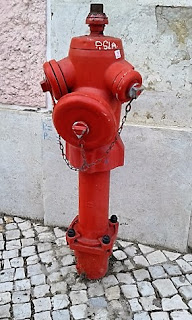 |
| The view of Rocamadour from the other side of the canyon |
When we first drove up to the city, we
were along one side of a canyon and you could see the rocks on the
other side.
 |
| All you could see at first. |
But until you come around the bend, you don't see any
houses. Then all at once it's “Wow!”
 |
| The "Wow" moment |
Not only is this built into the side of
a hill, but there is a beautiful chateau at the top, rampart walls,
and a whole bunch of chapels and churches.
 |
| The ramparts from across the way |
Why so many chapels in a town of not a
huge population? Well, Rocamadour is a Catholic pilgrimage site.
 |
| One of many chapels |
Long ago, like in the 10th
Century, a man fleeing persecution came to this area to live out the
rest of his life as a hermit. The French call him Saint Amadour, and
Rocamadour is the Rock of Amadour. Long later, a perfectly preserved
corpse was found here, said to be the corpse of the saint himself.
 |
| Another view of ramparts and the tower |
Pilgrims began their journey here, but
not only because the crypt of St. Amadour is here. In one of the
churches, the Chappelle de Notre Dame, there is a small walnut wood
statue of the Virgin Mary. This is called the Black Madonna. And it
is supposed to have miraculous powers.
 |
| The tower from another angle |
Pilgrims arrive at the base of the
cliff and then climb over 200 steps on their knees to reach the Black
Madonna. On their knees! That is dedication or religious fervor. We
decided against knee abuse and just used our well shod feet instead.
 |
| That's a long way up! |
The churches are a good way up from the
bottom. But they are not yet at the top. The ramparts and chateau are
even higher. We walked up the ramparts. Along the way is the Chemin
de la Croix, or the Stations of the Cross. As you walk up the path
replete with switchbacks, at each turning point there is a carved and
painted relief showing one of the stages of Jesus's crucifixion. I'm
not so up on the Christ story that I knew all the stages. But it
starts at the first stage where he is condemned to death, continued
through him falling three times, a man helping him carry the cross, a
woman cleaning the blood from his face, his mother crying, and
ultimately to his being placed on the cross, dying, and his body
being given to his mother. (I'm sure those are not all in the correct
order.) But I do know that there were thirteen stages.
 |
| Rocamadour |
In addition to the man-made wonders,
there are plenty of crevices and small caves in the rock face. And
sometimes, there is a mix of a natural cave and man-made pillars
along with it.
 |
| A cave with columns |
The buildings are beautifully detailed
with carvings and engravings.
 |
| So much detail |
In the city are two large archway
portals into parts of the town. These were from the 13th
Century.
 |
| Proof of the age |
One is just big enough for a small car to drive through, but
is mainly meant for pedestrians.
 |
| The smaller Porte |
The other is much larger, like a grand
castle gate. But that one is up so high no cars are even allowed up
to that point.
 |
| The larger Porte |
Rocamadour is a beautiful site, and it
makes one marvel at how people could have possibly built such a
thing. It would be a wondrous accomplishment with today's technology.
To imagine people in the 11th through 14th
Centuries building all of these structures is even more amazing.



































